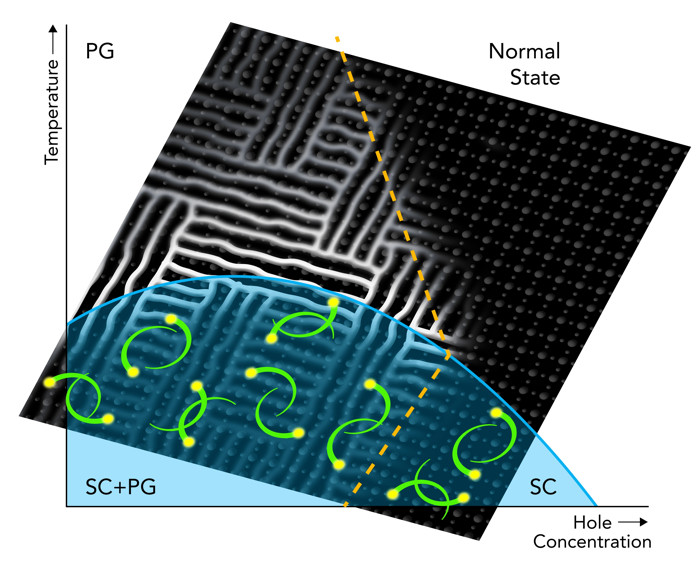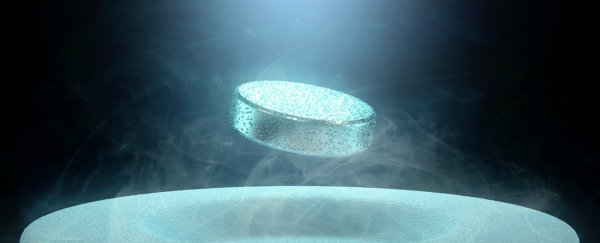For decades, scientists have been trying to achieve superconductivity - the ability for a material to carry a current with 100 percent efficiency - at high temperatures.
Superconductivity has the potential to revolutionise pretty much everything that relies on electricity, such as computing, our electricity grid, and transport. Because an electrical current can travel through these materials with no resistance, it means they're incredibly efficient and extremely cost effective. But we've struggled to achieve superconductivity at practical temperatures.
In the past, it was thought that superconductivity could only occur at close to absolute zero (around -273 degrees Celsius), but thankfully over the past couple of decades, scientists have managed to achieve superconductivity up to comparatively mild temperatures of -135 degrees Celsius.
Earlier this month, researchers even managed to acheive the incredible feat of superconductivity at room temperature for the first time ever - but only for (literally) a split second.
Despite the advances, it's always felt as though there was something standing in the way high-temperature superconductivity. And now scientists think they may know what that is - a mysterious phase of matter known as the "pseudogap".
For the past 20 years, researchers at Stanford University and the SLAC National Accelerator Laboratory in the US have been trying to work out whether the pseudogap was helping or hindering high-temperature superconducitivty.
And they've finally found the first direct evidence that this phase of matter steals electrons that would otherwise pair up and allow a material to superconduct.
"Now we have clear, smoking-gun evidence that the pseudogap phase competes with and suppresses superconductivity," said Makoto Hashimoto, the lead author, in a press release. "If we can somehow remove this competition, or handle it better, we may be able to raise the operating temperatures of these superconductors."
The relationship between the two phases is shown in the illustration below.
 SLAC National Accelerator Laboratory
SLAC National Accelerator Laboratory
The pseudogap was first spotted using a technique called angle-resolved photoemission spectroscopy (or ARPES), which knocks electrons out of a copper oxide material so that researchers can plot their behaviour and then work out how they would behave inside the material.
Researchers have been doing this for decades with copper oxides, one of the very few materials known to display superconductivity at relatively high temperatures of around -135 degrees Celsius.
During superconductivity, electrons leave their usual positions and pair up into something known as Cooper pairs, so that they can conduct electricity with zero resistance and 100 percent efficiency. The researchers were able to see this behaviour using ARPES as a clear gap in their plots of electron behaviour.
But the in the mid-1990s, they discovered another strange gap in their plots of copper oxide. It looked like the "superconducting" gap left by electrons moving into pairs, but it was being seen at temperatures far too high for superconductivity. They called this phase the pseudogap, and have been studying it ever since.
To finally work out what was happening, the team studied not only the energies and momenta of the electrons, but also the number of electrons of particular energies that come out of the material. They tested this over a wide range of temperatures and after altering the electronic properties of the material.
In their experiments, they found strong evidence that at the "transition temperature" of around -135 degrees Celsius, the pseudogap and superconductivity states in copper oxides are competing for electrons. Their results are published in Nature Materials.
"The pseudogap tends to eat away the electrons that want to go into the superconducting state," explained physicist Thomas Devereaux, who worked on the project, in the release.
"The electrons are busy doing the dance of the pseudogap, and superconductivity is trying to cut in, but the electrons are not letting that happen. Then, as the material goes into the superconducting state, the pseudogap gives up and spits the electrons back out. That's really the strongest evidence we have that this competition is occurring."
However, the team still doesn't know what's causing the pseudogap in the first place - and given their discovery it's a question that's more important than ever to answer.
But this new research gives them a starting point.
"Now we can model the competition between the pseudogap and superconductivity from the theoretical side, which was not possible before," said Hashimoto in the release.
"We can use simulations to reproduce the kinds of features we have seen, and change the variables within those simulations to try to pin down what the pseudogap is."
They're hoping that in the future this will help them to unlock superconductivity at much higher temperatures.
"Competition may be only one aspect of the relationship between the two states. There may be more profound questions - for example, whether the pseudogap is necessary for superconductivity to occur," added Hashimoto.
Source: ScienceDaily
